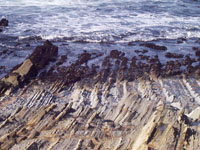6.17: Deep Sea Fan, Turbidite Deposits, and Abyssal Clays
- Page ID
- 10234
Deep Sea Fan, Turbidite Deposits, and Abyssal Clays
A deep-sea fan is a fan- or delta-shaped sedimentary deposit found along the base of the continental slopes, commonly at the mouth of submarine canyons. Deep sea fans form from sediments carried by turbidity flows (density currents) that pour into the deep ocean basin from the continental shelf and slope regions and then gradually settle to form graded beds of sediment on the sea floor. Deep-sea fans can extend for many tens to hundreds of miles away from the base of the continental slope and an coalesce into a broad, gently sloping region called a continental rise.
Graywacke is a fine-to-coarse-grained sedimentary rock consisting of a mix of angular fragments of quartz, feldspar, and mafic minerals set in a muddy base (commonly called a "dirty sandstone or mudstone" because of its mixed size fractions). Graywacke is the general term applied to sediments deposited by turbidity flows, and they commonly show graded bedding. Graywacke is a common rock-type in the Coast Ranges of California and other active continental margin regions around the world. It is exposed on land where tectonic forces push up rocks that originally formed in the deep ocean (examples in Figures 6-65 and to 6-66).
Turbidites are sedimentary deposits associated with turbidity flows—they commonly appear as interbedded layers of sandstone and shale. Conglomerate typically occurs in thicker beds and were originally deposited as gravel and mud on ancient submarine fans closer to the mouths of submarine canyons or in channels carved into the seabed.
Abyssal Clays
Abyssal clays are very fine-grained sediments, mostly clay minerals and iron-rich mineral dust that are mostly blow in by the wind from distant terrestrial sources. Much of the abyssal clay components are derived from dust storms in the world's desert regions and from explosive volcanic eruptions that can blow fine particles high into the atmosphere. Abyssal clays are also fine-grained material carried and redistributed by ocean currents such as tail end of far-turbidity currents that can travel hundreds to even thousands of miles away from continental margins. Abyssal clays in the deep ocean basins accumulate very slowly relative to other ocean sediments. Some of the fine-grained material can possibly be from cosmogenous sources in some locations. Abyssal clays dominate sediments on the seafloor in the northern Pacific Ocean basin (see discussion on volume and distribution of marine sediments (in Figure 6.18 above).




